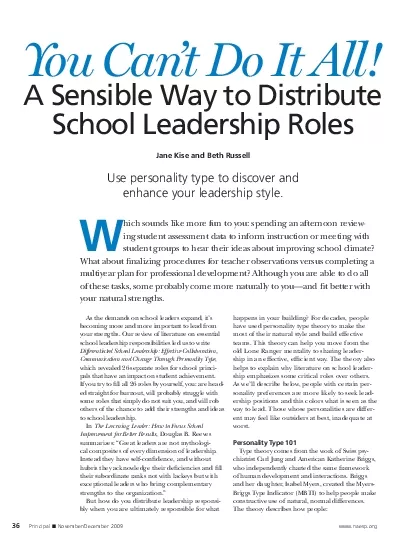

perceiving All of these indicators inuence how we lead how we teach and how we learn Most people nd that they perform at their best when tasks t their personalities School leaders can learn to perfor ID: 861784
Download Pdf The PPT/PDF document "wwwnaesporg" is the property of its rightful owner. Permission is granted to download and print the materials on this web site for personal, non-commercial use only, and to display it on your personal computer provided you do not modify the materials and that you retain all copyright notices contained in the materials. By downloading content from our website, you accept the terms of this agreement.
1 www.naesp.org perceiving). All of these
www.naesp.org perceiving). All of these indicators inßuence how we lead, how we teach, and how we learn. Most people Þnd that they perform at their best when tasks Þt their per-sonalities. School leaders can learn to perform all 26 of the essential principal roles, but some are energizing while others are of limited interest. In the opening example, reviewing assessment data Þts the strengths of the thinking functionÑmaking decisions based on logic and objective criteria. In contrast, building relationships with students Þts the strengths of the feeling functionÑmaking decisions by stepping into the shoes of those who will be affected and considering community values. Given that the Center for Applications of Psychological TypeÕs Atlas of Type Tables reveals that 80 percent of school princi-palsÑand an even higher percentage of superintendentsÑprefer thinking, is it any wonder that one reads more about using assessment data than qualitative data to guide decisions in books and research on school leadership? Beth, a principal, prefers feeling and co
2 nsidering impact on peopleÑand knows tha
nsidering impact on peopleÑand knows that working with assessment data isnÕt her strength. She shared responsibility for this role in several ways. She scheduled data retreats for grade-level teams. She asked district per-sonnel to lead the retreats, knowing that they could help teachers look at data in ways that would motivate, inform, and descriptions of the type preferences and the principal roles that Þ t each preference, think about what you prefer to do. How, by asking others to take on other roles, could you be a more effective leader? If you donÕt yet have a leadership team, consider who might bring complementary strengths to such a group. The visionary leader roles, such as acting as a change agent and optimizer, call on very different strengths. They naturally appeal to intuitive types who prefer to focus on the big picture, the future, and working to change rather than maintain the status quo. Beth prefers intuition. Her staff jokes that she returns from each conference she attends with a dozen new ideas for teachers to implement. She
3 asks other members of her leadership tea
asks other members of her leadership team to take on the sensing role to evaluate whether a new idea Þ ts with the school focus and, if so, help Beth plan the who, what, How Do You Make Decisions?An individualÕs preference for think-ing or feeling inß uences his or her decision-making style. While all prin-cipals need to be instructional leaders, thinking principals often naturally gravi-tate toward gaining extensive knowl-edge of curriculum and instruction, needed so that all students can learn. While thinking leaders focus on objec-tive data, feeling leaders focus on the bottom line of whether students are learningÑboth sets of roles have a direct impact on student achievement.Further, Jane is often hired by princi-pals whose staffs just ÒarenÕt getting the message,Ó or so the principal thinks. In nearly every case, the principalÕs per-sonality type is opposite the majority of the staffÕs. This isnÕt surprising because, according to the Atlas of Type Tables, 70 percent of principals prefer thinking and judging, for example, while only 27 percent
4 of teachers do.If you prefer thinking,
of teachers do.If you prefer thinking, your leader-ship team can help you think through possible courses of action in terms of how individuals on your staff may react. At one school where Jane con-sulted, the thinking principal missed several primary grade team meetings because she believed the staff was competent enough to work on their own. Most of the team members pre-ferred feeling. When Jane interviewed them, she discovered that the team interpreted the principalÕs absence as disinterest. ÒShe doesnÕt think it takes talent to teach 6- and 7-year-olds,Ó they said. The principal quickly increased her visibility and worked to correct the misunderstanding.How Do You Approach Planning and Implementation?To what extent do you enjoy plan-ning, whether for short-term or long-term goals? Those who prefer judging approach life through planning, empha-sizing closure. Judging principals often thrive on establishing goals and main-taining school focus. The Atlas of Type Tables indicates that more than 85 per-cent of school principals prefer judging. As a
5 school leader, you need to engage the pl
school leader, you need to engage the planning role to set con-crete goals that bring about major change. However, other responsibilities, such as monitoring progress and evalu-ating data, point to a need to stay open to new information and make mid-stream corrections no matter what the school improvement plan calls for. The perceiving preference for approaching life spontaneously, emphasizing staying open to more information, adds key ß exible leader roles. Whatever your preference, partner-ing with your opposite makes it easier to make sure the best of both preferences informs your school. Set the plan and get on with implementing while moni-toring to see if student achievement improves; if not, modify. You can use personality type as a model to pinpoint your strengths and blind spots. All types can be great school leaders. Successful leaders, however, use knowledge of their per-sonality types to continue to grow and develop even as they seek to partner with others who have complementary strengths so that all leadership roles are adequately cover